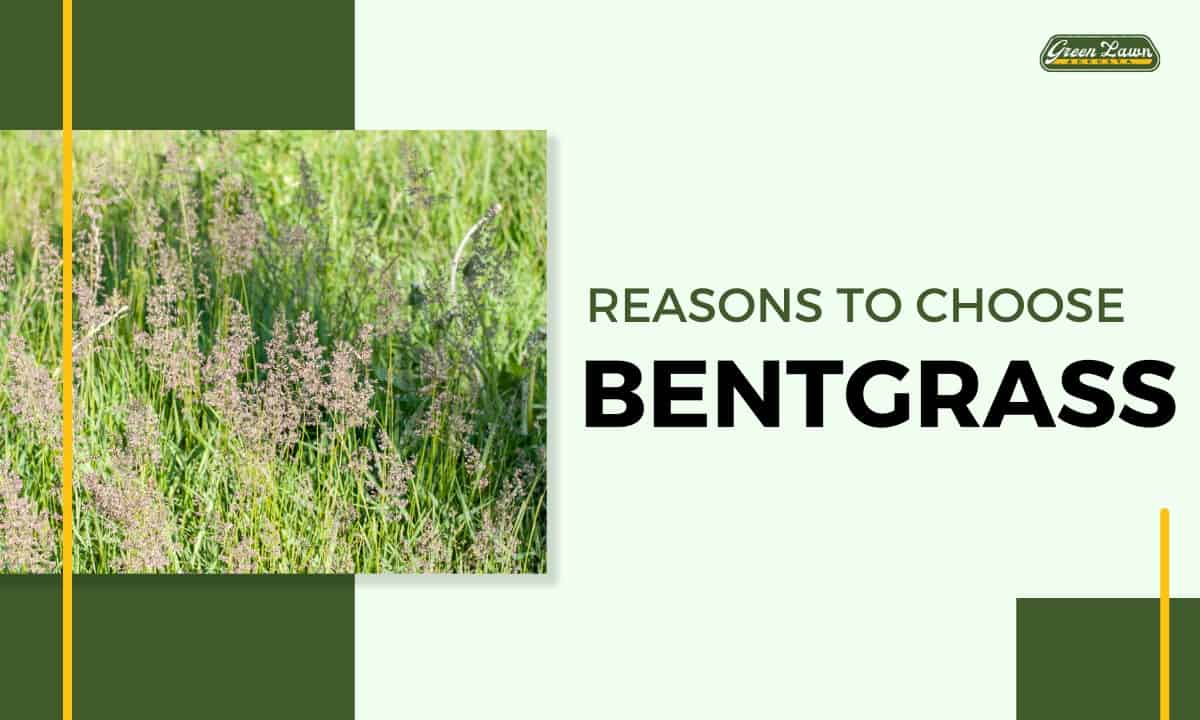From its adaptability to various climates to its high tolerance for low mowing, bentgrass has many superb strengths that make it a top-choice turfgrass.
Table of Contents
ToggleKey Takeaways
- Bentgrass is a water-efficient and sustainable turfgrass option, making it suitable for areas with limited or expensive water resources and contributing to resource conservation.
- Bentgrass enhances the visual appeal of landscapes, golf courses, and sports fields, adding beauty and charm to outdoor spaces.
- Bentgrass is drought-resistant and can withstand dry conditions and limited water availability, making it ideal for regions with arid or semi-arid climates.
- Bentgrass is suitable for golf courses and sports fields, as it can handle heavy foot traffic, recover quickly from damage, and provide a consistent playing surface for golfers and athletes.
Bent Grass’s Attractive Appearance
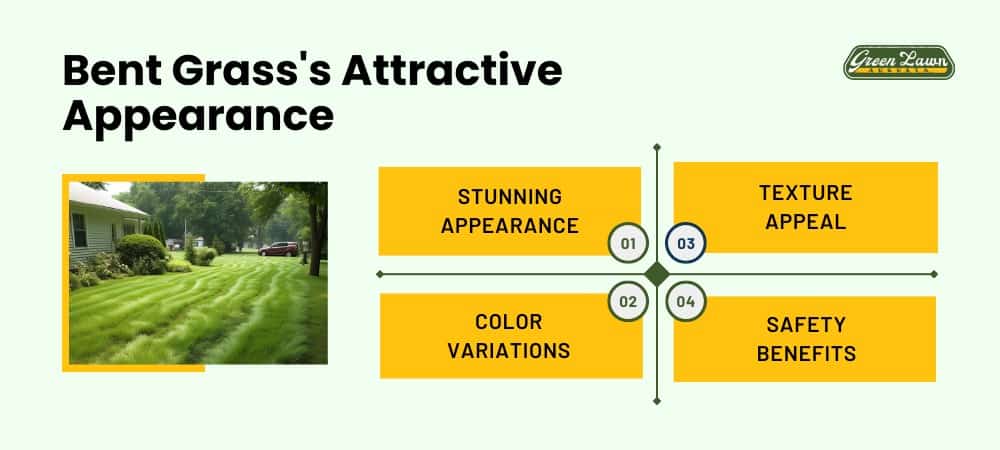
Bent Grass species is highly prized for its vibrant hue. It has a verdant green that stands out in any landscape and can maintain its rich color throughout most of the year, even in cooler seasons.
Moreover, its fine, tightly packed blades form a dense carpet-like surface. This not only offers an appealing aesthetic but also provides resistance to wear and tear.
As a result, bentgrass is an excellent choice for high-traffic areas.
Lush Green Color
Bentgrass’s lush green color is eye-catching, making it a popular choice for many landscapers and homeowners.
You might have noticed this vibrant hue on golf courses or in high-end landscapes. This is largely due to the types of bentgrass used, such as creeping bentgrass or colonial bentgrass.
Each variety brings a unique shade of green to your lawn, contributing to its overall appeal.
When you plant bentgrass seed or lay bentgrass sod, you invest in a turfgrass that maintains its color throughout the year.
Even in cooler climates, bentgrass remains green, adding a touch of freshness to your outdoor space. This is a significant strength of bentgrass, one of many reasons this turfgrass is a top choice.
Fine, Dense Texture
Bentgrass’s unique texture can be attributed to its fine leaves and tightly knit growth habit, making it a top choice when considering bentgrass vs. Bermuda.
Native bentgrass, a cool-season grass, grows in dense mats with a fine texture pleasing to the touch. Its dense growth pattern also helps to crowd out weeds, reducing the need for chemical herbicides.
Bentgrass identification is simple due to its unique, fine texture and the slight sheen that its leaves exhibit.
What is bentgrass’s main advantage? Its ability to tolerate low mowing heights makes it ideal for golf courses and other sports turfs.
Finally, its fine texture provides a smooth and even surface, perfect for a professional-looking lawn.
High Tolerance to Low Mowing
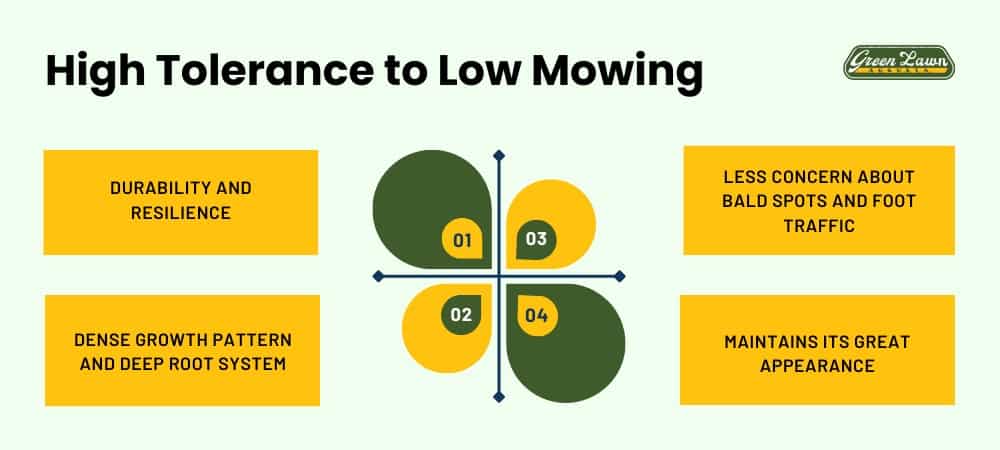
You’ll be amazed at how bentgrass tolerates low mowing remarkably well. Its ability to withstand frequent cutting maintains its quality even at short heights that other grass species might find challenging.
This attribute isn’t just a testament to its robust nature and adaptability, ensuring it always presents a consistently attractive appearance.
Withstands Frequent Cutting
One major advantage is that you can frequently cut bentgrass without causing any harm, making it an ideal choice for golf courses and homes that require constant maintenance.
This grass has evolved to exist in short, dense formations and thus can withstand constant shearing. Its dense growth habit ensures it recovers quickly from mowing, maintaining a lush and attractive appearance.
To give you a clearer picture, let’s consider a table:
| Property | Effect | Benefit |
|---|---|---|
| Dense Growth | Quick Recovery | Less Damage |
| Short Formation | Withstands Shearing | Constantly Neat |
| Evolved for Cutting | Regular Mowing | Ideal for Golf Courses |
In a nutshell, bentgrass is a top-notch choice for high-maintenance areas due to its ability to withstand frequent cutting.
Maintains Quality at Short Heights
Moving on from its remarkable resilience to frequent cutting, let’s delve into another one of bentgrass’s superior strengths – it’s capacity to maintain its quality even at short heights.
This feature is essential, particularly for golf courses and sports fields where a short, uniform, dense turf is crucial. Bentgrass uniquely fulfills this requirement by sustaining its rich color, density, and texture even when trimmed to less than a quarter of an inch.
Furthermore, it reduces the risk of scalping – an unsightly and damaging condition caused by cutting grass too short.
Adaptability to Different Climates
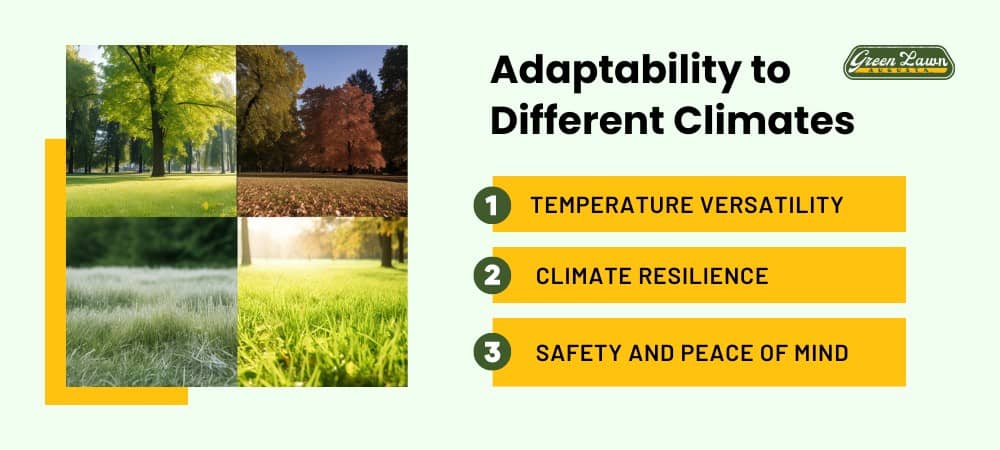
You’ll find that bentgrass truly shines in its adaptability to various climates. It thrives best in cool, temperate areas, demonstrating its resilience against frost and low temperatures.
However, don’t be quick to dismiss its performance in hotter climates; with adequate irrigation, it can tolerate and even flourish in heat, showcasing its versatility as a turfgrass.
Thrives in Cool, Temperate Areas
If you’re living in cool, temperate areas, you’ll find that bentgrass truly thrives, making it a fantastic choice for your lawn or golf course. It’s specially adapted to flourish in these kinds of environments, and here’s why:
- Cold Tolerance: Bentgrass can withstand chilly temperatures, maintaining its green hue even during frosty winters.
- Low Nutrient Requirement: Unlike other grasses, bentgrass doesn’t need a lot of nutrients to grow healthy and strong.
- Shade Tolerance: Bentgrass can grow well, even in shaded areas, making it versatile for different garden layouts.
- Disease Resistance: Bentgrass is robust against common turf diseases, ensuring longevity.
- Fine Texture: Bentgrass boasts a fine, dense texture, perfect for creating beautiful, carpet-like lawns.
Tolerates Heat With Adequate Irrigation
Despite the heat, you’re lucky because your lawn can flourish beautifully with sufficient irrigation. Bentgrass, a cool-season turfgrass, is known for its heat tolerance. This may be a surprise, considering it thrives in cooler climates, but the key lies in its deep root system. This allows it to reach deep-seated moisture and nutrients and withstand hotter temperatures.
However, it’s essential to maintain adequate irrigation during heat waves. The grass may become dormant and lose its lush, green appearance. But no worries! Proper watering allows your bentgrass lawn to stay vibrant and healthy, even in the sweltering summer heat.
Bent Grass’s Environmental Benefits
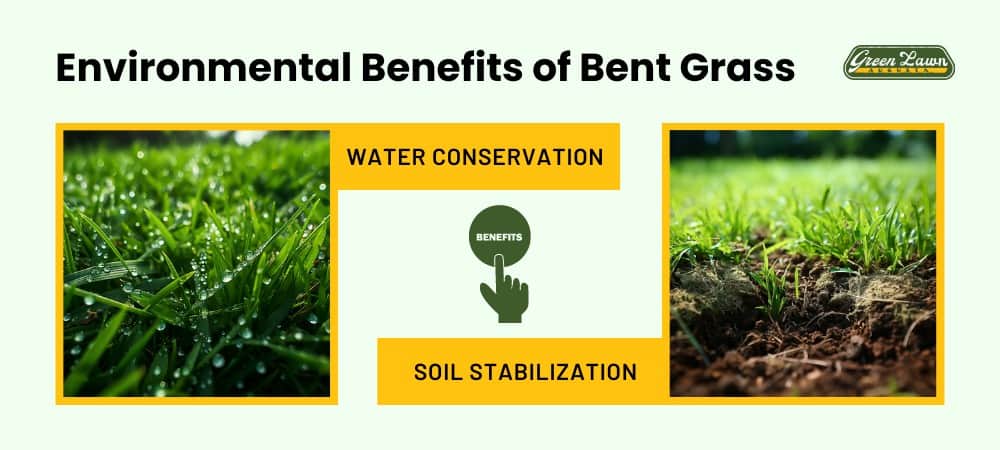
For one thing, it requires less fertilizer than many other grasses, which can significantly reduce harmful runoff entering our waterways.
Additionally, bentgrass needs less water than many other turfgrass varieties, making it a more sustainable choice, especially in areas prone to drought or water restrictions.
Requires Less Fertilizer
Bentgrass doesn’t need as much fertilizer as other turfgrasses, saving you time and money in the long run. This is because bentgrass has a dense, fine-textured growth habit that enables it to utilize nutrients effectively. This feature reduces the frequency and amount of fertilizer applications required, leading to significant savings in maintenance costs.
To provide a clearer picture, let’s compare the fertilization needs of bentgrass with other common turfgrasses:
| Turfgrass | Fertilizer Requirement (lbs/1,000 sq. ft/year) |
|---|---|
| Bentgrass | 2-4 |
| Kentucky Bluegrass | 3-5 |
| Bermudagrass | 2-6 |
| Tall Fescue | 4-6 |
The table shows that bentgrass requires the least fertilizer, making it a cost-effective and environmentally friendly option for your lawn or golf course.
Needs Less Water Than Other Grasses
Another plus is that it’s less thirsty than most other grasses, so you’ll also save on your water bill. Bentgrass can remarkably thrive with less moisture than many other turfgrass species. This trait makes it a more sustainable choice, especially in areas with limited or expensive water resources.
The reasons for its low water requirement are rooted in its unique physiological and morphological characteristics:
- It has a dense, shallow root system that efficiently captures water.
- Bentgrass possesses a waxy leaf surface that minimizes water loss through evaporation.
- Its fine leaf texture allows it to resist drying out even under intense heat.
- The grass can enter a state of dormancy during drought conditions, significantly reducing its water needs.
Conclusion
In conclusion, it’s clear why this grass is so popular for various applications. With its fine texture and vibrant hue, bentgrass presents an aesthetically pleasing sight that’s hard to match.
But it’s not just about looks. Its drought-resistant nature and low water requirements make it a sustainable choice in a world increasingly conscious of resource conservation. And when paired with expert care through Augusta lawn care and lawn treatment services, bentgrass becomes one of the most attractive and sustainable options available.
If you’re exploring other turfgrass types for your Georgia lawn, check out ryegrass, Zoysia grass, or even Bermuda grass to compare their strengths.
Frequently Asked Questions on Bentgrass
Does bent grass possess invasive characteristics?
Bentgrass is often considered invasive due to its aggressive growth habits. It spreads quickly via above-ground stems called stolons and can easily take over other best grass types for Augusta. Its dense mat-like structure can suffocate other plants, and it’s resistant to many common herbicides, making it difficult to control once established.
Is it possible to manually remove bentgrass?
Manually pulling out bentgrass is possible, but it’s not the most effective method for large infestations. The grass reproduces via stolons, and any remaining fragments can regrow. Manual removal and herbicide application may be necessary for effective results.
What makes bent grass a superior type of grass?
Bentgrass is popular for its fine texture, high density, and ability to tolerate close mowing, making it ideal for golf courses and other sports fields. It also provides a uniform, lush green appearance.
Are bent grass and creeping bentgrass the same thing?
Yes, bent grass and creeping bentgrass refer to the same plant. The term ‘creeping’ is added because of its growth habit, spreading horizontally by means of stolons.
Can I cultivate bent grass in my garden?
Yes, you can grow bentgrass in your yard. However, due to its aggressive growth and vulnerability to diseases, it requires high maintenance, including frequent watering, fertilizing, and mowing. It is best suited for cooler climates.
How does the proliferation of bentgrass occur?
Bentgrass spreads through stolons, horizontal stems that grow above the ground. These stolons can root at the nodes to form new plants, allowing the grass to spread quickly and form a dense mat.

